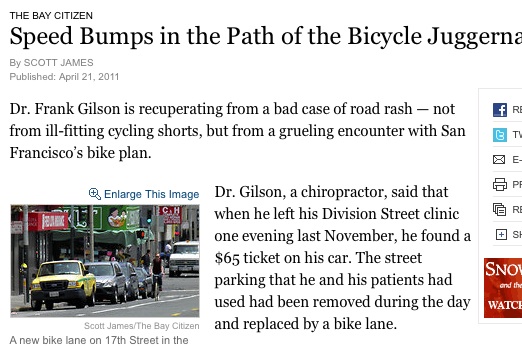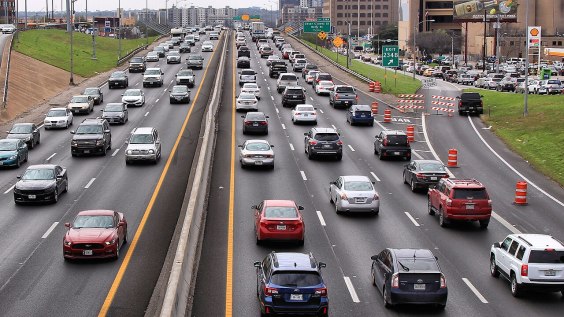In light of Scott James’ egregious hit piece on the Bike Plan that ran in the New York Times today, I’ve decided to write the editors of that paper a letter, from a genuine resident of 17th Street.
What does family-friendly mean? What’s more important: safety or parking? Do most San Franciscans ever ride a bike in the city?
Before I get to all of those questions, can I suggest to you a different framing and headline for the Scott James article that ran today: Cyclists and pedestrians still left exposed because a few people oppose safe street plan.
If that sounds like the biased view of a former transit reporter, then consider this. Just this past Wednesday, as I rode my bike down 17th Street through the intersection with Dolores, I was struck by a minivan going the opposite direction that was making a left turn onto Dolores. I was thrown to the ground, lucky to only be bruised and scraped. My bike, by contrast, was totaled from the impact. I was lucky to be in decent enough shape to console the driver of the minivan, who was deeply shaken by the crash.
To paraphrase James: I’m recovering from a bad case of road rash – not from ill-fitting cycling shorts in which I wouldn’t be caught dead, but from the direct impact of a collision with a left-turning driver on 17th Street who didn’t see me traveling straight on my bike through the green light until it was too late.
Can you imagine why I’d be rubbed the wrong way by Mr. James’ suggestion that building a safer bike lane is anti-family and anti-senior citizen?
Count me in among the “emerging group of residents and businesses raising concerns about how the city is carrying out its ambitious bike lane agenda.” When the city compromises on safety to satisfy a few vocal people, citizens have every reason to raise concerns. As part of the compromise on 17th Street, the SFMTA agreed not to remove parking it planned to replace with bike lanes. Instead, it has added extremely narrow bike lanes next to the parking that are not up to the standard prescribed by the National Association of City Transportation Officials’ in its recently released set of urban bike facility guidelines.
The crash I was in wouldn’t have been avoided with better bike lanes – it would take a focused effort to address the left-turn visibility issue at the intersection. But many hundreds of cyclists, myself included, will be exposed to a greatly increased dooring or clipping risk on the new stretch of bike lanes because the compromise solution was implemented. The compromise was on safety, and anyone who hopes to ride a bike in the city lost.
Another line in James’ column got to me: “city leaders had forgotten that most people did not bicycle (7 percent of trips in the city are by bike, according to the coalition), including parents who must shuttle children or those with physical limitations.” A more salient figure is that 7 in 10 San Franciscans rode a bike in the city in 2009, according to a David Binder poll, and every day on my bike ride, I spot more and more parents shuttling their kids on bikes. After my crash, it makes me cringe all the more to think that the city isn’t doing everything it can to make the ride safer for those parents who choose to make an environmentally friendly decision that gets their kids out in the fresh air every morning.
In the building I live in, every unit has a garage space, and most are occupied with cars (a higher rate than the 70 percent of households in the city as a whole that own a vehicle), but almost all of the tenants also own bicycles, which can be found in the garage as well. This is hardly atypical. Glance into any open garage in the city and you’re likely to spot as many bikes as cars.
Which makes you wonder: does family-friendly mean lots of parking and streets that are unsafe to walk or bike on? Or does it mean streets that are safe enough for all users, from small children to seniors? Shouldn’t there at least be some streets in San Francisco that are safe for everyone, even if it means converting a few hundred of the city’s 280,000-plus on-street parking spaces to curbside bike lanes?
I write this not as a maniacal speeding bicyclist but as a regular San Franciscan, someone who was too intimated to ride a bike on city streets when I first moved to 17th Street. After all, at Streetsblog, I was the Muni reporter, not the bike reporter, and wrote well over a hundred stories about the former and perhaps two dozen on the latter. Only through hours of staring out the window at my stretch of 17th Street, the personification of Jane Jacobs’ eyes on the street, did I build up the fascination and courage to try riding myself. My use of transportation modes, from walking to transit to biking to driving, couldn’t be more balanced. The most common long ride I make is from home to my brother’s house in the Richmond to visit my two young nephews. When I ask for safe and family-friendly streets, I mean that I literally want to be able to visit my family safely.
It would be easy to take Mr. James to task for trying to bring the trumped-up controversy over bike lanes to San Francisco, and for attempting to turn a strong woman who advocates for safer streets in San Francisco into the next focus of undeserved controversy, just like another strong woman who works for safer streets in New York. But I’d rather turn the attention from Mr. James’ attempt to gain traction on anti-bike sentiment to the need for truly safe facilities for everyone in this city.
We know that bicyclists and pedestrians (in other words, just about every person in San Francisco) both face grave danger from cars on the city's streets. After all, 755 pedestrians were injured by cars in the city in 2008, and 390 bicyclists were in injury collisions with vehicles. By contrast, there were just 21 pedestrian-bicycle injury collisions, none of them fatal, belying James' rhetoric portraying bicyclists as the biggest menace to pedestrians. Pedestrian and bicycle safety is a shared goal, founded on calming traffic.
So what am I to do about Mr. James' piece? Of course, the thing my parents taught me to do in such situations.
My parents were both journalists. One of them still is. That meant they were avid readers of the local newspapers, and when the newspaper ran a story they found particularly slanted or poorly done, their recourse was to cancel their subscription. This usually would last for a month or two, during which time I’d feel inconvenienced about not being able to read the sports section or the comics, but it was a quiet yet poignant form of protest, sometimes against the very newspaper my dad used to work for.
That’s why I’m glad I’ve recently signed up for the New York Times’ new online subscription system. When the otherwise stalwart institution of journalism runs an article like Mr. James’ piece today, I have the satisfying recourse of canceling my subscription. And that’s exactly what I’m going to do. No doubt my partner and I will find this an inconvenience for the next month or two, but journalism in the nation’s finest paper needs to be held to a high standard. An overtly slanted article marked by a suburban obsession with automotive storage over the safety of bicyclists and pedestrians is not up to that standard.
Michael Rhodes is a former Muni reporter for Streetsblog. He is currently a master's student at UC Berkeley's Department of City and Regional Planning.







